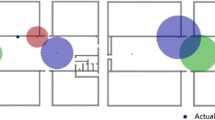Abstract
WiFi based indoor and semi-indoor localization techniques are essential components of indoor location-based services. Calibration-free techniques for WiFi signal strength based indoor localization can help make indoor localization systems scalable, cost-effective and easy to deploy. However, distance estimation errors and environmental factors affect the accuracy of non-calibration solutions like trilateration significantly, and addressing the accuracy issue is critical. To help improve accuracy, localization over dual-band WiFi (IEEE 802.11n) which uses both 2.4 GHz and 5 GHz bands is a potential alternative. This paper proposes a novel adaptive, weighted trilateration technique that uses the behavior of these two bands under different conditions. An iterative heuristic approach based on the characterization of the behavior of the bands is employed to determine the most likely position of a smart phone. Additionally optimization strategies are applied to improve the time complexity of this approach. Experiments conducted in different indoor environments show that our approach performs better than other non-calibration signal strength based approaches in terms of accuracy, and also reduces the worst case error.
This work has been funded in part by DST (India) grant DyNo. C/4902/IFD/2016–2017.
Access this chapter
Tax calculation will be finalised at checkout
Purchases are for personal use only
Similar content being viewed by others
References
Ibrahima, M., Moselhib, O.: IMU-based indoor localization for construction applications ISARC. In: Proceedings of the International Symposium on Automation and Robotics in Construction (2015)
Bilodeau, J.-S., Bouzouane, A., Bouchard, B., Gaboury, S.: An experimental comparative study of RSSI-based positioning algorithms for passive RFID localization in smart environments. J. Ambient. Intell. Hum. Comput. 9, 1–17 (2017). https://doi.org/10.1007/s12652-017-0531-3
Wen, Y., Tian, X., Wang, X., Lu, S.: Fundamental limits of RSS fingerprinting based indoor localization. In: 2015 IEEE Conference on Computer Communications (INFOCOM), Kowloon, pp. 2479–2487 (2015)
Yang, Z., Wu, C., Zhou, Z., Zhang, X., Wang, X., Liu, Y.: Mobility increases localizability: a survey on wireless indoor localization using inertial sensors. ACM Comput. Surv. 47(3), Article 54 (2015)
Shi, G., Ming, Y.: Survey of indoor positioning systems based on ultra-wideband (UWB) technology. In: Zeng, Q.-A. (ed.) Wireless Communications, Networking and Applications. LNEE, vol. 348, pp. 1269–1278. Springer, New Delhi (2016). https://doi.org/10.1007/978-81-322-2580-5_115
Xiao, J., Zhou, Z., Yi, Y., Ni, L.M.: A survey on wireless indoor localization from the device perspective. ACM Comput. Surv. 49(2), Article 25, 31 p. (2016)
Gu, Y., Lo, A., Niemegeers, I.: A survey of indoor positioning systems for wireless personal networks. IEEE Commun. Surv. Tutor. 11(1), 1332 (2009). https://doi.org/10.1109/SURV.2009.090103
Shanmugaapriyan, P., Chitra, H., Aiswarya, E., Balasubramanian, V., Kumar, S.A.: A pragmatic approach for effective indoor localization using IEEE 802.11n. In: Garcia Pineda, M., Lloret, J., Papavassiliou, S., Ruehrup, S., Westphall, C. (eds.) Ad-hoc Networks and Wireless. ADHOC-NOW (2014)
Xiaozhen, Y., et al.: IT-QEAS: an improved trilateration localization method through quality evaluation and adaptvie optimization selection strategy. In: 2017 Prognostics and System Health Management Conference (PHM-Harbin), Harbin, pp. 1–6 (2017)
Sundar, D., Sendil, S., Subramanian, V., et al.: WALE: a weighted adaptive location estimation algorithm. Ambient Intell Human Comput (2018). https://doi.org/10.1007/s12652-018-0940-y
Abu-Sharkh, O.M.F., Al-hamad, A.M., Abdelrahim, T.M., Akour, M.H.: Dynamic multi-band allocation scheme for a stand-alone wireless access point. In: 2012 26th Biennial Symposium on Communications (QBSC), pp. 168–173, May 2012
Liu, H., Darabi, H., Banerjee, P., Liu, J.: Survey of wireless indoor positioning techniques and systems. IEEE Trans. Syst. Man Cybern. Part C Appl. Rev. 37(6), 10671080 (2007)
Chen, C., Chen, Y., Lai, H., Han, Y., Liu, K.J.R.: High accuracy indoor localization: a WiFi-based approach. In: 2016 IEEE International Conference on Acoustics, Speech and Signal Processing (ICASSP), Shanghai, pp. 6245–6249 (2016)
Parvin, H., Alizadeh, H., Minati, B.: A modification on k-nearest neighbor classifier. Glob. J. Comput. Sci. Technol. https://computerresearch.org/index.php/computer/article/view/650
Bahl, P., Padmanabhan, V.N.: RADAR: an in-building RF-based user location and tracking system. In: Proceedings of 19th Annual Joint Conference of the IEEE Computer and Communications Societies (INFOCOM 2000), Tel Aviv, Israel, vol. 2, pp. 775–784, March 2000
Jiang, J.A., et al.: A distributed rss-based localization using a dynamic circle expanding mechanism. IEEE Sens. J. 13(10), 3754–3766 (2013)
He, S., Ji, B., Chan, S.G.: Chameleon: survey-free updating of a fingerprint database for indoor localization. IEEE Pervasive Comput. 15(4), 66–75 (2016)
Soorty, B., Sarkar, N.I.: Finding a closest match between wi-fi propagation measurements and models. In: 2015 2nd Asia-Pacific World Congress on Computer Science and Engineering (APWC on CSE), pp. 1–6. IEEE (2015)
Author information
Authors and Affiliations
Corresponding author
Editor information
Editors and Affiliations
Rights and permissions
Copyright information
© 2019 Springer Nature Switzerland AG
About this paper
Cite this paper
Mathivannan, S., Srinath, S., Shashank, R., Aravindh, R., Balasubramanian, V. (2019). A Dynamic Weighted Trilateration Algorithm for Indoor Localization Using Dual-Band WiFi. In: Kawai, Y., Storandt, S., Sumiya, K. (eds) Web and Wireless Geographical Information Systems. W2GIS 2019. Lecture Notes in Computer Science(), vol 11474. Springer, Cham. https://doi.org/10.1007/978-3-030-17246-6_14
Download citation
DOI: https://doi.org/10.1007/978-3-030-17246-6_14
Published:
Publisher Name: Springer, Cham
Print ISBN: 978-3-030-17245-9
Online ISBN: 978-3-030-17246-6
eBook Packages: Computer ScienceComputer Science (R0)




